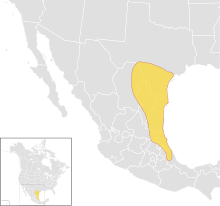Long-billed thrasher
| Long-billed thrasher | |
|---|---|
 |
|
| In south Texas, United States | |
| Scientific classification | |
| Kingdom: | Animalia |
| Phylum: | Chordata |
| Class: | Aves |
| Order: | Passeriformes |
| Family: | Mimidae |
| Genus: | Toxostoma |
| Species: | T. longirostre |
| Binomial name | |
|
Toxostoma longirostre (Lafresnaye, 1838) |
|
 |
|
| Long-billed thrasher range | |
| Synonyms | |
|
Orpheus longirostris |
|
Orpheus longirostris
The long-billed thrasher (Toxostoma longirostre) is a medium-sized resident songbird of South Texas and eastern Mexico. It bears a strong resemblance to its close relative the brown thrasher in appearance, calls, and various other behaviors; however, the two species do not overlap in range except in the winter when the brown thrasher will temporarily reside in the northern range of the long-billed.
The bird is a large sized mimid that is not especially wary, but it will take precautionary measures to prevent itself from being potential prey. Like other thrashers, it is named after its sweeping methods when searching for food, not for thrashing predators, although they are aggressive defenders of their territories.
The specific name longirostre is derived from the Latin words longus long and rostrum bill.
There are two subspecies of the long-billed thrasher. T. longirostre longirostre was first described in scientific literature by Frédéric de Lafresnaye in 1838 as Orpheus longirostris, while T. longirostre sennitti was described by Robert Ridgway a half-century later.
T. c. sennitti (Ridgway, 1888) Sennett's thrasher. Range extends from southern (particularly south central) Texas to the Rio Grande Valley and the Mexican states of Tamaulipas and San Luis Potosi.
T. c. longirostre (Lafresnaye, 1838). Range is in eastern Mexico, within the states of Querétaro, Tamaulipas and Veracruz southward to Puebla.
Along with the brown thrasher and Cozumel thrasher, the three are part of a superspecies rufum clade. Plumage patterns and bill shapes were originally used for grouping, and the birds also were shown as closely related with genetic studies.
...
Wikipedia

